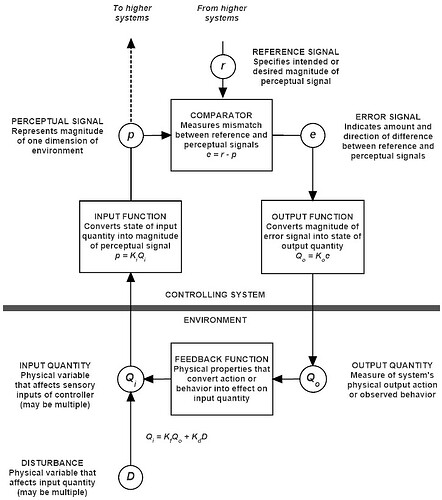[From Fred Nickols (2015.11.07.1405)]
Franklin Lenk’s inquiry prompts a question on my pertaining to the diagram below (a copy I made for my own use, not for publication).
Let’s take a simple live example. I was out on my back deck and noticed a nail sticking up from one of the planks. I got a hammer and pounded it back down.
The controlled variable was the nail. My reference signal for it was “flush with the plank” or “not sticking up.”
The output quantity was getting and then swinging a hammer so that it struck the nail on the head and drove it down flush with the plank.
Now if Qi is the controlled variable, the nail, and Qo is my behavior, I’m left wondering about the box labeled Feedback Function. What are the “physical properties that converted my action or behavior in effect on the nail”? Is it simply “striking the nail with a hammer”?

The attached visual was created with SmartDraw, The World’s First Visual Processor™
To edit this file, download a free SmartDraw trial at www.smartdraw.com
Regards,
Fred Nickols, CPT
DISTANCE CONSULTING
“Assistance at a Distance”
The Knowledge Workers’ Tool Room
Be sure you measure what you want.
Be sure you want what you measure.
PCT Formal Model.SDR (60.5 KB)
[From Rick Marken (2015.11.07.1250)]
···
Fred Nickols (2015.11.07.1405)–
Â
FN: Franklin Lenk’s inquiry prompts a question on my pertaining to the diagram below (a copy I made for my own use, not for publication).
Â
FN: Let’s take a simple live example. I was out on my back deck and noticed a nail sticking up from one of the planks. I got a hammer and pounded it back down.
Â
FN: The controlled variable was the nail. My reference signal for it was “flush with the plank� or “not sticking up.�
RM: Remember, a controlled variable is a variable. So the controlled variable in this situation has to be something like “distance of nail head from top of plank”. The reference is “zero distance” which is the same as “flush with plank”. So your description of the reference is correct.
Â
FN: The output quantity was getting and then swinging a hammer so that it struck the nail on the head and drove it down flush with the plank.
 RM: Your output is really just the torque you applied to the hammer. That’s basically the same as “swinging the hammer” so you could verbally describe your output that way.
Â
FN: Now if Qi is the controlled variable, the nail, and Qo is my behavior, I’m left wondering about the box labeled Feedback Function. What are the “physical properties that converted my action or behavior in effect on the nail�? Is it simply “striking the nail with a hammer�?
RM: The feedback function is the “laws of physics” that relate the torque you apply to the hammer, Qo, to the amount of change in the position of the nail, Qi, with each swing. This function depends on the mass of the hammer head, M, and the resistance of the wood, R. So the feedback function will be a physical function, g(), that relates Qo to Qi, taking M and R (at least) into account. So the feedback function is:
Qi = g(Qo,M, R)
RM: Â I think M and R can be considered disturbances to the state of the controlled variable since their contribution to changes in the value of Qi is independent of yours (Qo). But they are basically constant disturbances.Â
BestÂ
Rick
Â
Â
Â
Â
Â
Â
The attached visual was created with SmartDraw, The World’s First Visual Processor™>
To edit this file, download a free SmartDraw trial at www.smartdraw.com
Â
Â
Regards,
Â
Fred Nickols, CPT
DISTANCE ** CONSULTING**
“Assistance at a Distance�
The Knowledge Workers’ Tool Room
Be sure you measure what you want.
Be sure you want what you measure.
Â
Â
–
Richard S. MarkenÂ
www.mindreadings.com
Author of  Doing Research on Purpose.Â
Now available from Amazon or Barnes & Noble

